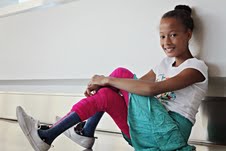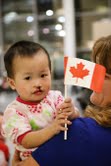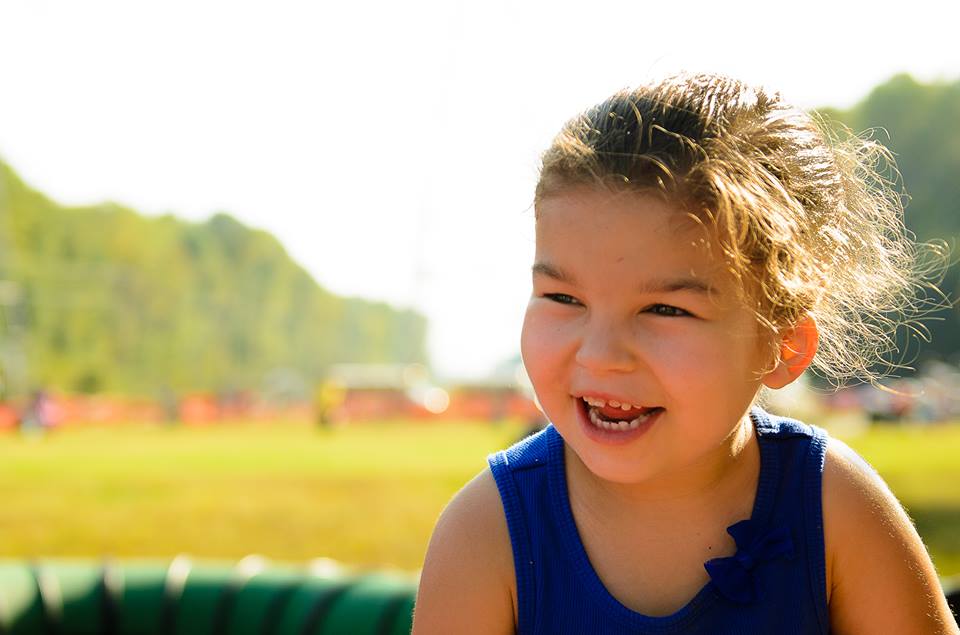
Photo: Squeaker and YoYo Photography
I love photographing all of three of my children -- their achievements, their everyday routines, and the little things that make them who they are. But, capturing my child with special needs can be a challenge. She has a range of disabilities, including autism, that pose challenges to getting her to look at the camera or even to look up from whichever favorite picture book or colorful magazine has captured her attention. She also has a range of adaptive equipment she uses daily, including a wheelchair, hearing aid, and orthotics. Deciding how, or even whether, to include these tools she relies upon in photographs poses challenges as well.

Photo: Squeaker and YoYo Photography
So, I was beyond thrilled when I picked up a copy of the new book, Your Child in Pictures: The Parents' Guide to Photographing Your Toddler and Child from Age One to Ten by famed "momtographer" Me Ra Koh and found an entire chapter dedicated to photographing children with special needs. Given how many families have a child with some type of special need this topic deserves a lot more attention then it gets. All parents want good photos of their children and children with special needs deserve an equal place in family photos as well and they deserve just as many photos documenting their childhoods as their typically developing peers.
Me Ra explains why she included an entire chapter on capturing children with all types of disabilities in her book, Your Child In Pictures:
One of the most incredible honors I've had in my career is to photograph the beauty of children with special needs. These moms have taught me how difficult a family photo can be. The term Special Needs seems to blanket over a myriad of scenarios. This is why I dedicated a special section to this important, often undiscussed topic, in my latest book. There isn't one photo tip that will work for all. But I have learned that, for example, if you are working with an autistic child, it's imperative that you don't cover up your face with the camera when taking the photo. They need to keep eye contact with you to stay engaged. Instead, use your Live View to compose the photo so that your face can stay uncovered. They may still look away but their engagement will be felt in the photo.
I have picked up in looking for ways to photograph my own child with special needs, both from experience and from a photographer very experienced in photographing children with special needs, Sylvia Eng of Squeaker and YoYo Photography. Also, check out this article for tips on photographing any child. Some may work for your child as well!
•Whenever possible ask for your child's input. You may be dreaming of garden photos in a pastel dress, but by allowing your child to have as much input as possible into the process you are more likely to have a happy and cooperative child. There are lots of decisions to be made, from location, to time of day, to wardrobe, to theme or activity, to displaying or hiding special equipment. Once you have started the shoot, be ready to follow your child's lead even if it's not exactly what you had planned or agreed upon in advance.
•Have patience. Photographing any child relies on patience and a little luck, but this is even more so with children with special needs. Allot sufficient time to get "the shot." If you taking a photo for a holiday card or to document another special occasion start early to reduce stress and try again if you need to.

Photo: Squeaker and YoYo Photography
•Be ready. When photographing a child with special needs shoot constantly and always be ready for the moment when they make eye contact, smile, or let their guard down to allow their personality to shine through. This also means using a higher shutter speed, if your camera allows, to make sure you get a sharp photo of what could be a fleeting moment. If your camera has continuous mode use it to get multiple shots quickly. Also, have your camera with you as much as possible to help ensure you do not miss an unexpected opportunity to get a great shot. I invested in a cute camera bag, the Cabriolet by ShutterBag, so that I don't mind lugging my fancy camera with me and not look like I'm carrying a camera. I also have a LowePro NovaSport that is waterproof so that I can take my camera with me in bad weather while still having enough room for all the kid stuff I always need.
•Choose a location in which your child is comfortable. This could be a favorite park or as specific as a particular place in your home. If possible, choose a time with good light and, if going out in public, few crowds.
•Try to set everything up for the shoot before your child is brought over for photos. For example, if you want a family photo in front of the Christmas Tree make sure the tree is exactly as you want it before calling your child over. If your child will be drawing or playing with LEGOs during your shoot have everything set out before your take out your camera.
•Consider allowing your child to hold a favorite toy or lovey. Not only will this provide your child with some comfort and give them something to do with their hands, it will also give you the opportunity to capture your child with a cherished part of her childhood.
•Avoid using the flash, which may startle or upset your child and, at the very least, will draw more attention to the fact that the child is being photographed. This may result in darker photos, but that can be solved easily by doing some basic editing to brighten the photo using a free program such as PicMonkey or by using an editing program such as Adobe Photoshop Elements, which can be purchased for under $100.00.
•If the child has a hard time making eye contact try to have someone or something near the camera to capture their attention. The person could be a parent or someone else who is trusted. Alternately, someone could hold a prop near the camera that interests the child. It can be a favorite toy or even a phone tuned into YouTube.
•If you are using a DSLR, use an aid, such as a DaisyGrip or ShutterBuddy to help get your child's attention. The DaisyGrip is ingenious because it attaches to your camera's hot shoe and can hold nearly anything. For example, If a child is obsessed with trains you can put a Thomas the Tank Engine toy in the DaisyGrip and ensure the child looks right at the camera. You can also use it to insert a phone playing a video, which works well for my daughter. Another idea is to stick puppets right on top and have the puppet dance, fall off, or engage in whatever activity will get the child to look. Colorful toys that move around might also work to get a child's attention. ShutterBuddies are another option. They fit around your lens, come in a variety of styles, and even have squeakers, which can often get children to look at the camera.
•Allow your child to play or engage in a favorite activity, such as drawing or playing with toy cars. By getting on the same level as your child while they are doing something they enjoy you may be able to capture some wonderful natural expressions, even if direct eye contact is not being made. By asking the child about the activity you may be able to get her to look at the camera just long enough to get a shot with great eye contact.

Photo: Squeaker and YoYo Photography
•Try to be in some shots with your child to make her more comfortable. This can be done with a few inexpensive tools. A tripod will help you get the right angle. The Joby Gorillapod is made in a variety of styles to handle everything from DSLRs with zooms, to point and shoots, to phone cameras. It's affordable, can be brought anywhere, and bent into nearly any position you need to get the right perspective. Joby also makes other tools that make it easy to get into photos for those using DSLRs, such as the UltraPlate and a handstrap with UltraPlate that make it a cinch to quickly attach and detach your camera from the tripod while still using a study strap. Once your camera is on the tripod set it to self-timer and get in position. If you are using a DSLR, you can purchase a camera remote for about $10.00 or use interval timing on your camera as an alternative. SONY also has an innovative new device that allows you to use your phone to preview and trigger your camera. Me Ra Koh explains how it is used. Rumors are that other manufactures are developing similar technology.
•Give lots of praise throughout the shoot and show the child any great photos you get on your camera. This may help put the child at ease and boost their confidence.
•Be prepared to move a lot and change things around. It may be difficult to move around much with children with special needs. So, you should be prepared to get lots of different angles by moving yourself and getting a different perspective. Get up high, down low, move from side to side. You should also be prepared with ways to make shots more interesting with the child in the same place. One idea is to change the background by incorporating balloons, streamers, flowers, etc. to give shots taken in the same place a different feel.
•If the child uses adaptive or medical equipment, if possible ask them if they would like the equipment incorporated into the shots or not. Some children may consider a hearing aid or wheelchair part of who they are. Some may not. Consider a variety of shots with and without the equipment. For shots without equipment, you could safely place a child who uses a wheelchair on soft grass or a chair with a lot of support. Breathing tubes could possibly be covered with coordinating scarves or even a toy. Be sensitive to your child. Do not send the message that a wheelchair should be hidden by suggesting that your child get out of her chair for a photo. On the other hand, if it is your child's wish to be photographed out of her chair then do what you can to make this possible even it means not using your ideal location. Plan this out carefully ahead of time.

Photo: Squeaker and YoYo Photography
•Approach your photos in new ways. Instead of going after the "smile for the camera and say cheese" approach, approach your photo taking as a documentary of your child's life through "lifestyle" photos that capture the everyday from reading with Daddy to getting ready for school. You may even consider a "day in the life" or "week in the life" project where you choose a day and take a photo every hour of whatever your child is doing for a day or a week. You can choose to include therapy and doctor's visits as they may be an important part of your child's story.
•Consider creative ways of getting family shots. It can be a challenge getting everyone to look good in family photo even when all members of the family are typically developing. You can use what works to try to get the shot -- for my family using the DaisyGrip with my iPhone tuned to cartoons usually works. If that fails, consider using a montage or storyboard to include the great photos you do get of your child with special needs into a variety of shots that are put together to tell the story of your family.
• Finally, let go of the idea of the "perfect shot." Have fun, capture your child doing what she loves where she loves to do it, and enjoy the time you spend planning and having the photo shoot. Many Moms find the images they love most are not the ones with a child smiling perfectly for the camera, but the images that capture the essence of who their child is. Those are the memories you will treasure.

Photo: Squeaker and YoYo Photography
Now go get some beautiful photos of your child!
Here's one of mine. She's not looking at the camera and she's squinting, but she's radiant and smiling and I think it captures her perfectly.
